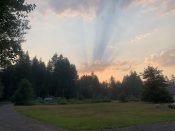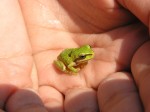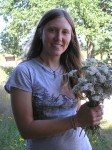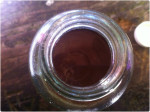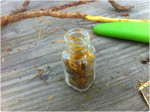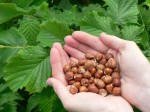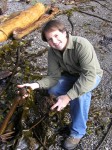Chorus Frogs Singing
March 1, 2013 – The Pacific Tree Frog (Pseudacris regilla) is our regional “chorus frog” and we heard them singing in an impressive chorus for the first time this winter a couple hours before we turned our calendar to March. We’d been hearing a “ribbit” here and a “crek-ek” there for a few weeks but nothing like the singing that’s going on now. According to the weather blog by local celebrity Cliff Mass, Professor of Atmospheric Sciences at the University of Washington, we’re experiencing an unusual warm front so maybe that’s what prompted the boys to all start calling for mates!
Winter Wrens Courting with Brilliant Song

The Winter Wren (Troglodytes hiemalis) is one of our many winter resident birds who are furiously working to stake-out their territories, court and mate before migrants return from the south. We witnessed a male displaying and singing to engage a demure female who entered his territory. There was another male nearby vying for her attention as well. And neither paid us much mind as we listened to their beautiful voices and watched their antics. You can easily tell wren from other species in this region because they usually holds their tails at an upward angle. They’re small, brown, reclusive little birds that are mostly seen hopping and flitting about on the forest floor (sometimes reminding me of a little mouse). While looking on the Cornell Lab of Ornithology website for more information regarding the length of it’s song, I learned that per unit weight, the Winter Wren delivers its song with 10 times more power than a crowing rooster. That seems like an even more impressive feat if you’ve ever been near a rooster delivering his glorious morning song. Not only that, I also learned that their songs (typically 5-10 seconds in length) are made up of about 36 notes per second. I think it’s one of the most distinctive and magnificent songs in the forest.
Great Blue Herons Nesting
A few Great Blue Herons (Ardea herodias) started building nests near our local fish hatchery last year at this time. Over the past week, the number of nests doubled from 5 to 10! Just a note for anyone planning to visit a heron rookery (aka heronry) is to leave a buffer of at least a thousand feet around the perimeter because these birds will flush (rouse or fly off) easily with the smallest disturbance. Notice the two more prominently featured herons in the picture on the left. They were calling to each other and posturing as the one on the left flew in and landed on their nest. Amazing to behold.
Coltsfoot Flowers Bolting Up

We were really excited to find this lovely Asteraceae family plant coming up along the trail in an especially moist part of the park (there’s an underground spring coming out of the hillside nearby – more on that in another post). Palmate coltsfoot (Petasites frigidus) grows from an underground rhizome (horizontal stem). The leaves shoot up from the rhizome separately from the flower stem and at slightly different times (leaves after flower stem).
The most interesting thing for me about this plant, though, is the information about it’s use and edibility. Many of the references I could find on the internet (from herbalists to end-of-the-world survivalists) claim that the ashes from the burned leaves are a salt substitute. I found 1 story where someone tried it and said it did not taste salty to them. I have done it and it had absolutely no salty taste at all. However, the much-respected Plants of the Pacific Northwest Coast by Pojar and MacKinnon (without exception, my #1 go-to field guide on plants in this region) does not mention this trait in its entry. My #1 go-to book on plant family information and identification (Thomas Elpel’s Botany in a Day) only mentions the salt option when referencing another book (Edible and Medicinal Plants of the West by Gregory Tilford). So, I grabbed that one off the shelf and he writes that “The entire aboveground plant has a mild but distinctive saltiness, a trait that prompted its early use as a salt substitute.” A quick check of Michael Moore’s Medicinal Plants of the Pacific West (an excellent, regional guide) supports my growing suspicion – there is no mention of salt in his coltsfoot section. Interestingly, Elpel says that plants in the Goosefoot family (ie lamb’s quarters, spinach, quinoa) accumulate salts from the soil and can be used as salt substitutes either burned/ash or unburned. Perhaps someone got the names confused somewhere along the line? In researching the Goosefoot family I found a several references mentioning that a member of the Atriplex genus called Saltbush could be burned and the ashes were used as a baking powder substitute.
Another issue worth considering is the use of the common name versus the scientific name. There are several species of coltsfoot included in more than one genera, so be mindful that you are reading about the right one when researching. Many sites talk about the edibility of the plant and fail to mention it has alkaloids in it that can do really bad things to your liver. Some sites did, however, post warnings and suggest using in moderation. Some say to eat the flower stalks and young spring leaves. While others say the alkaloids are present in higher quantities in the young leaves and flowers and to only use the older leaves.
This is one of the things we warn our students about – unless you’ve tried it and it has worked for you, you’ve had a doctor or other professional prescribe it based upon their education and experience (and it worked for you) or you find 3 independent and trustworthy sources that confirm it, do NOT pass off information as being true. It is possible that there is a special process to be used and I did it wrong, or perhaps other types of coltsfoot would work where palmate did not. Or maybe there are people out there who have tried it and it worked for them personally and I didn’t happen to come across their information (or perhaps they never thought to post it in the first place). I would absolutely love to know if anyone has first-hand experience with this or can shed more light on the process used or more details.
Stinging Nettles Ready To Harvest
The stinging nettles have grown by several inches since my last post, and they’re the perfect height for easy harvest and utilization. I’ve already made a fabulous batch of raw nettle pesto that was enjoyed by our Sumas homeschool and Bellingham adult classes (recipe to follow later this month).
Indian Plums Blooming


The Indian Plum (Oemleria cerasiformis) flowers are emerging and cascading down – a notable change from my last blog entry. Spring (in behavior, though not yet in name) is truly upon us. Within a week, I suspect all of the Indian Plums will be covered with blossoms. And you can see from the photos below there are some other plants emerging from the soil or blossoming. Can you identify them? I’ll put their names at the end of the post. What plants are emerging or blossoming where you live?



Top row: Salmonberry (Rubus spectabilis), Pacific Bleeding Heart (Dicentra formosa)
Middle: Red Elderberry (Sambucus racemosa)
Bottom row: Pacific Waterleaf (Hydrophyllum tenuipes) and Mountain Sweet Cicely (Osmorhiza berteroi).
Check out these upcoming Wolf College courses on emerging plants, migrating birds and other signs of spring:
• Spring Classes in Washington & Oregon: Local Wild Edible Plants & Backcountry Herbal Medicine; Safety, Tracking & Bird Alarms in Wolf, Cougar & Bear Country
• Spring Workshops in Western Washington: Wild Foods Foraging & Herbal Medicine Making; Understanding Birds and Their Voices
• Camps & Expeditions: Wild Ethnobotany & Herbalism Training; Wolves & Wildlife Trackers Training


